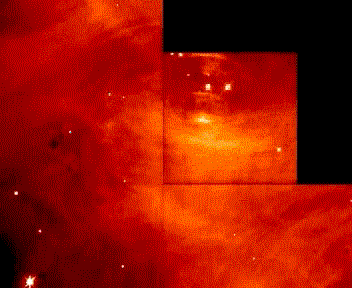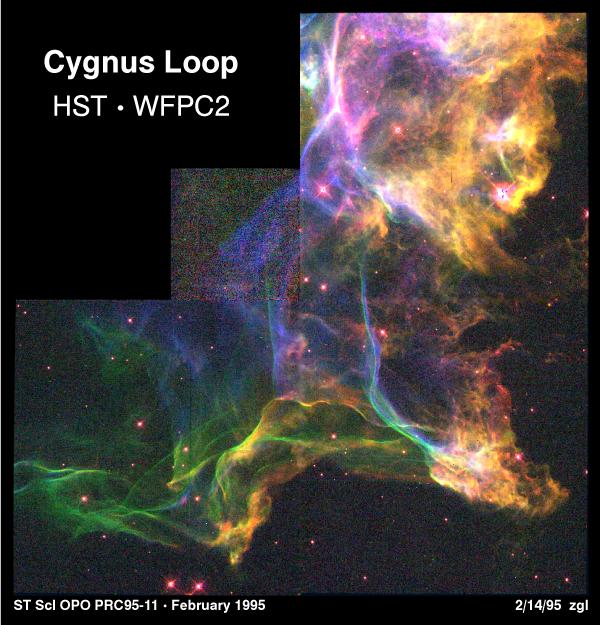Most of what we know about supernova remnants has been learned from a few examples that exploded recently and are relatively close, as we discuss below.
Supernova 1987a
In February, 1987, a star exploded as a supernova in the Large Magellanic Cloud, a small companion galaxy to the Milky Way.
 |
"Before" to the immediate left and "after" to the far left.from http://heasarc.gsfc.nasa.gov/docs/xte/xte_images.html |
This is the closest supernova to have gone off since Cas A about 320 years ago.
We learned many details of the supernova
process by studying 1987a:
 |
In fact, about 10 billion neutrinos passed through each of you! Fortunately, they do not react easily. (from http://hyperphysics.phy-astr.gsu.edu/hbase/astro/sn87a.html) |
 |
The neutrinos are generated in the last stages of the collapse leading to the supernova, where electrons and protons merge at the high pressure and temperature, and produce neutrons and neutrinos. (animation by G. Rieke.) |
 |
From SN 1987a, we learned that the character of a supernova
may depend on the type of star exploding -- most supernovae were though to be red
supergiants just before the explosion while 1987a was a blue supergiant (from G. Smith, http://casswww.ucsd.edu/public/tutorial/SN.html) |
- Unfortunately, all the gravity wave detectors were out of service when 1987a exploded
 |
Prior to the explosion, material appears to have been ejected in two opposite pointing cones, hence the two large ellipses projected against the sky in the top part of the picture. Below, we can just see material leaving the remnant. |
|
 |
More on SN 1987A at: http://heritage.stsci.edu/public/feb4/sn1987anino.html
Cas A
 |
X-Ray image of the 320-year-old supernova, Cas A. The low, medium,
and higher X-ray energies of the Chandra data are shown as red, green, and blue
respectively. The image shows remarkable structure in the debris of a gigantic
stellar explosion, as well as an enigmatic source in the center, which could be a rapidly
spinning neutron star or black hole. This image shows the later development of
a remnant like that around SN1987a. (from NASA/CXC/SAO, http://chandra.harvard.edu/photo/2002/0237/0237_hand.html)
|
 |
This infrared image shows where dust grains have formed in the remnant and been heated by the hot plasma that produces the x-rays. The grains are made of simple silicates and aluminum oxide, minerals that are the building blocks for rocks on Earth (and ones that can survive in the harsh environment in the supernova remnant). (image from MIPS instrument on Spitzer, D. Hines/G. Rieke) |
 |
This lovely composite image shows the infrared in red, optical in yellow, low-energy x-ray in green, and high-energy x-ray in blue. The infrared traces tiny heated dust particles, the optical shows where there are emission lines from gas, and the x-ray traces very hot gas. (from O. Krause, G. Rieke, Spitzer Science Center, Caltech/JPL) |
The Crab Nebula
The supernova that produced the Crab Nebula was observed in 1054 A.D. by Chinese astronomers -- knowing the actual year of the explosion has enabled a greater understanding of this pulsar and supernova remnant. The remnant is below as seen in the optical (to the left the whole nebula and to the right its core).

 |
The radio structure is very similar to that in the optical. Most supernova remnants are thin and wispy -- why is the Crab so energetic? (from NRAO/VLA) |
 |
This animation based on a series of HST images shows energy from the
pulsar whipping up the nebula around it and keeping it energized -- including with the
energetic sea of electrons that makes it glow. The animation starts with the view in the still to the upper right and then zooms in and zooms again until you are looking just at the pulsar. |
 |
In the X-ray, the view is dominated by the activity driven by the pulsar. In this composite picture, X-rays are blue and optical light (from the HST images above) in red. (from J. Hester et al., HAT/NASA via astronomy picture of the day, http://antwrp.gsfc.nasa.gov/apod/ap050326.html) |
 |
This animation starts with the image above (rotated a bit) and
locates the pulsar and a shock front. It then zooms in, pauses briefly, and then runs
through a short sequence of X-ray images that show the shock moving outward through the
hot gas in a ring surrounding the pulsar. This is the way the pulsar energy escapes to
power the nebula. From Chandra Photo Album, http://chandra.harvard.edu/photo/category/quasars.html
Models that fit the image show this behavior more clearly for
comparison with the image, plus two jets coming out in opposite directions and
perpendicular to the ring |
The Crab Nebula pulsar is one of the fastest (and we now know therefore youngest) pulsars known.
| Aging supernova remnants
As supernova remnants age, they expand into interstellar space and deposit material highly enriched in heavy elements into the surrounding space.
|
 |
 |
Starting from the the upper left. interstellar material compresses
into high density clouds mostly of molecular hydrogen where stars and planets form (upper
right). The massive stars rapidly run through their main sequence lifetimes (lower right),
building up heavy elements, and then explode as supernovae (bottom center). The heavy
elements in their interiors escape in these explosions, and more are made during the
explosions themselves. The enriched remnants of these stars expand into the interstellar
medium (lower left) and merge with the interstellar material to be swept up in the next
cycle of star formation.(by G. Rieke, upper
left from Spitzer Science Center, http://www.spitzer.caltech.edu/Media/releases/ssc2004-08/ssc2004-08a.shtml
upper right by Don Dixon, http://www.cosmographica.com/gallery/
lower right from Voyager Project http://voyager.jpl.nasa.gov/multimedia/flash_html.html;
center bottom from Chandra Science Center, http://chandra.harvard.edu/photo/2002/0237/0237_hand.html
lower left from Space Telescope Science Center. http://www.spacetoday.org/DeepSpace/Telescopes/GreatObservatories/Hubble/
|
Where do the elements heavier than hydrogen and helium come from![]()
Test your understanding before going on![]()

Simulation of effect of a nearby supernova on a star like the sun. http://www.pnl.gov/energyscience/ |

An illustration from Chinese mythology of the Milky Way, from Postel & Guerrero http://www.artistexpo.com/Collprints.html |
|
Click to return to syllabus |
||
| Click to return to Novae and Supernovae | hypertext |
Click to go to the Milky Way |






